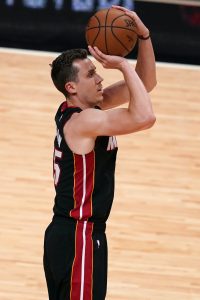On Monday, we took an in-depth look at what we knew about the NBA’s 2021 draft lottery standings and projected draft order so far based on the regular season standings, and what was still to be determined based on play-in results, random tiebreakers, and the lottery results.
With the play-in tournament nearly over, we can fill in a few more gaps. Let’s dive in…
Lottery standings
Having been eliminated from playoff contention, the Pacers will be at No. 13 in the lottery standings, giving them a 1% chance at the first overall pick and a 4.8% shot at a top-five selection, per Tankathon.
A tiebreaker will be necessary to determine whether the Spurs or Hornets get the edge in the lottery standings, but they’ll occupy the Nos. 11 and 12 spots in the lottery standings. The winner of the tiebreaker – to be conducted next Tuesday – will have a slightly higher chance of earning the first overall pick (1.8% to 1.7%) and a top-four pick (8.5% to 8.0%).
The No. 14 spot in the lottery will be held by the loser of Friday’s Warriors/Grizzlies play-in game.
Draft order
Having clinched playoff spots, the Wizards and Celtics will draft 15th and 16th, respectively, in the first round.
The winner of tonight’s Warriors/Grizzlies play-in game will draft 17th, while the Lakers will be part of a Tuesday tiebreaker to determine their exact position — they could draft as high as 21st and as low as 23rd.
If the Lakers had missed the postseason, teams like the Heat, Knicks, and Hawks each would have been pushed down one spot in the draft. Since L.A. made it, those teams will stay put, starting with Miami at No. 18.
Notable traded second-round picks
On Monday, we focused on what would happen with 2021’s traded first-round picks. So many of this year’s second-round picks have been traded that we’re not going to run through all of them in this space (you can check our tracker for the full details), but here are a few notable second-round swaps worth flagging:
The Pacers traded their second-round pick to the Nets with 45-60 protection. Because Indiana’s second-rounder is going to land at No. 44, that pick will be sent to Brooklyn rather than being protected.
The Bulls, who will be involved in a first-round tiebreaker with the Pelicans (and Kings) to determine their spots in the lottery standings, also have the ability to swap second-round picks with New Orleans. In the event of a random tiebreaker, the second-round order is always the inverse of the first-round order — for instance, if Team A wins a first-round tiebreaker over Team B, then Team B would get the higher pick in the second round. But in this case, the Bulls could win the first-round tiebreaker, then use their second-round swap to make sure they pick ahead of the Pelicans in both rounds.
Because the Warriors‘ first-round pick will fall in the top 20, Golden State will keep it and will instead have to send the Timberwolves’ second-round pick to the Thunder to complete last year’s Kelly Oubre trade. That pick will be No. 36.
The Suns had agreed to send their second-round pick to the Grizzlies if it landed between 31-35 and to the Nets if it landed between 36-60. It’ll go to Brooklyn, since it’s the No. 59 overall selection. Memphis is simply out of luck, as Phoenix’s obligation to the Grizzlies is now extinguished.
The Bucks will get the first pick of the second round (No. 31), since the Rockets have the ability to swap their second-rounder for Milwaukee’s first-rounder (No. 24).
Other early second-round picks that will change hands include the Pistons‘ No. 32 pick (to the Knicks), the Cavaliers‘ pick at either No. 34 or 35 (to the Pelicans), and the Raptors‘ No. 37 pick (to the Pistons).
 With all that in mind, let’s check in on how this year’s RFAs-to-be will be impacted by the starter criteria. Listed below are the former top-14 picks on track for restricted free agency who have not met the starter criteria. These players will be eligible for qualifying offers worth $7,031,451.
With all that in mind, let’s check in on how this year’s RFAs-to-be will be impacted by the starter criteria. Listed below are the former top-14 picks on track for restricted free agency who have not met the starter criteria. These players will be eligible for qualifying offers worth $7,031,451. The players listed below signed as second-round picks or undrafted free agents, but have met the starter criteria and are now eligible for a qualifying offer worth $4,736,102.
The players listed below signed as second-round picks or undrafted free agents, but have met the starter criteria and are now eligible for a qualifying offer worth $4,736,102.